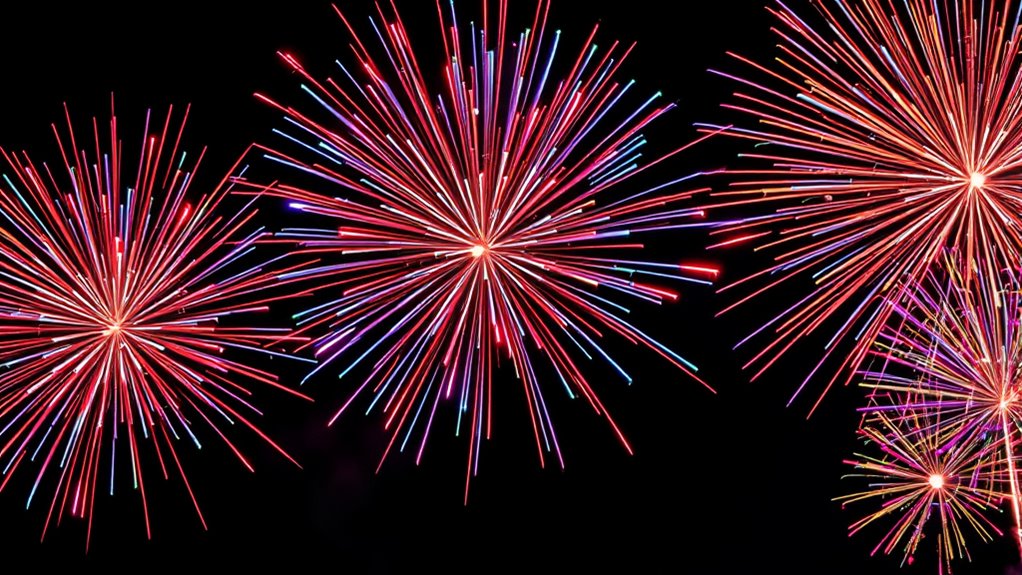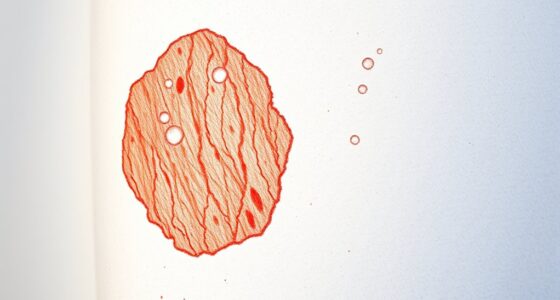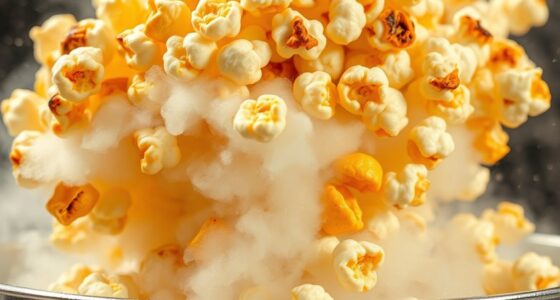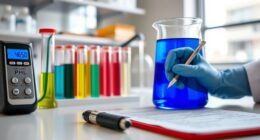Fireworks get their colors through chemical reactions involving metal salts that emit specific light wavelengths when heated during combustion. When the fireworks ignite, the heat excites electrons in metal atoms, causing them to jump to higher energy levels. As the electrons fall back, they release photons that produce vibrant colors like red from strontium, green from barium, or blue from copper. If you’re curious, you’ll discover even more about how these dazzling effects are created behind the scenes.
Key Takeaways
- Metal salts in fireworks, when heated, emit specific colors by releasing photons at characteristic wavelengths.
- Heat excites electrons in metal atoms, which then fall back to lower energy states, producing visible light.
- Different metal elements (e.g., strontium, barium, copper) produce distinct colors based on their atomic emission spectra.
- Chemical purity and particle size influence the brightness and vibrancy of the colors produced.
- Advanced techniques like layered effects and organic compounds enhance color intensity and variety.
The Science Behind Color Production in Fireworks
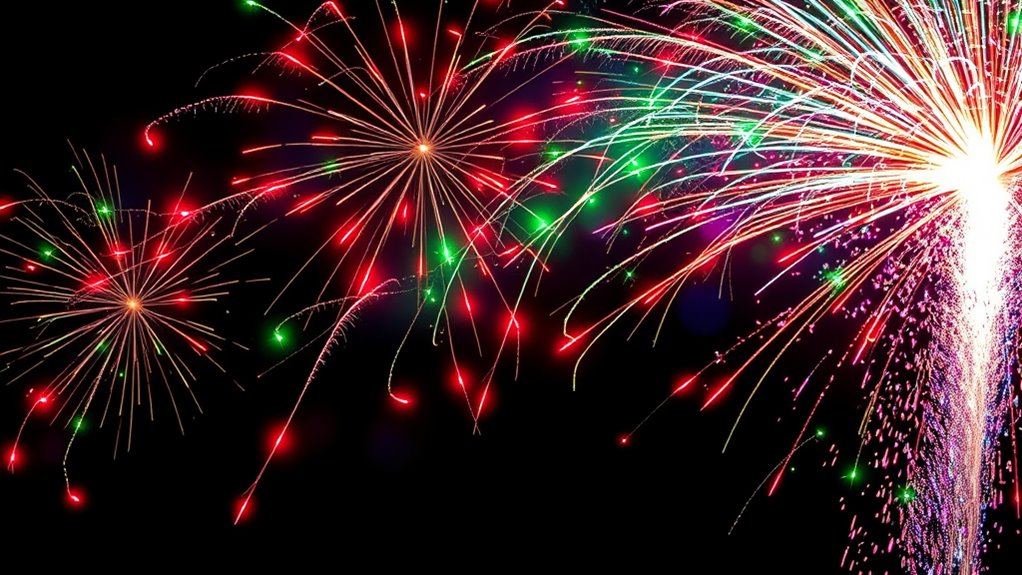
Fireworks produce vibrant colors through precise chemical reactions involving metal salts. When you ignite a firework, the heat causes these salts to reach temperatures between 1700 and 2000°C, triggering atomic excitation. This process relies on the heat energy to excite the electrons within the metal atoms. As atoms absorb energy, electrons jump to higher energy levels. When they return to their ground state, they emit light at specific wavelengths, creating the colors you see. Different metal salts are responsible for different hues: sodium produces yellow, barium yields green, and strontium gives red. The chemical composition of these salts determines the color, as each element’s electrons transition at unique energy levels. Additionally, the metal salt purity plays a crucial role in the vibrancy and consistency of the colors produced in fireworks.
Key Elements That Create Vibrant Hues
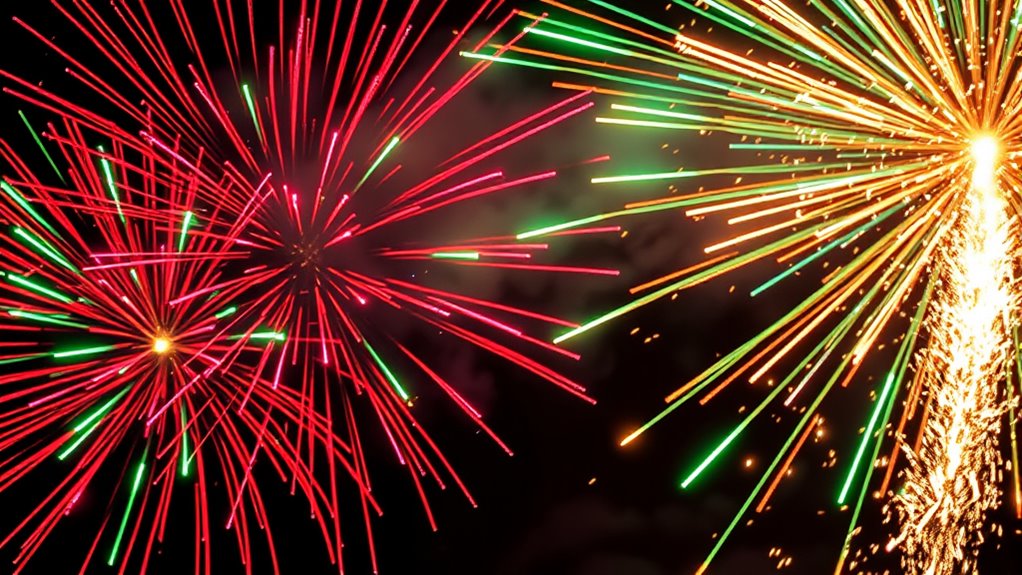
Certain metal elements are essential for producing the striking colors seen in pyrotechnics, with each element emitting specific hues when heated. Barium compounds, like barium chloride, create bright green flames due to their unique electronic shifts. These compounds are carefully chosen for their stability and vivid color output. Strontium salts, such as strontium carbonate, produce deep red colors because of their electron configuration, and combining strontium with nitrates intensifies the red. Copper compounds, especially copper chloride, yield vivid blue tones, while mixing copper with strontium results in purple or lavender shades. Sodium salts emit bright yellow light, and calcium salts produce warm orange hues. Metallic elements like magnesium, titanium, and zirconium generate white or silver sparks, adding brilliance and sparkle.
Chemical Reactions Responsible for Firework Colors
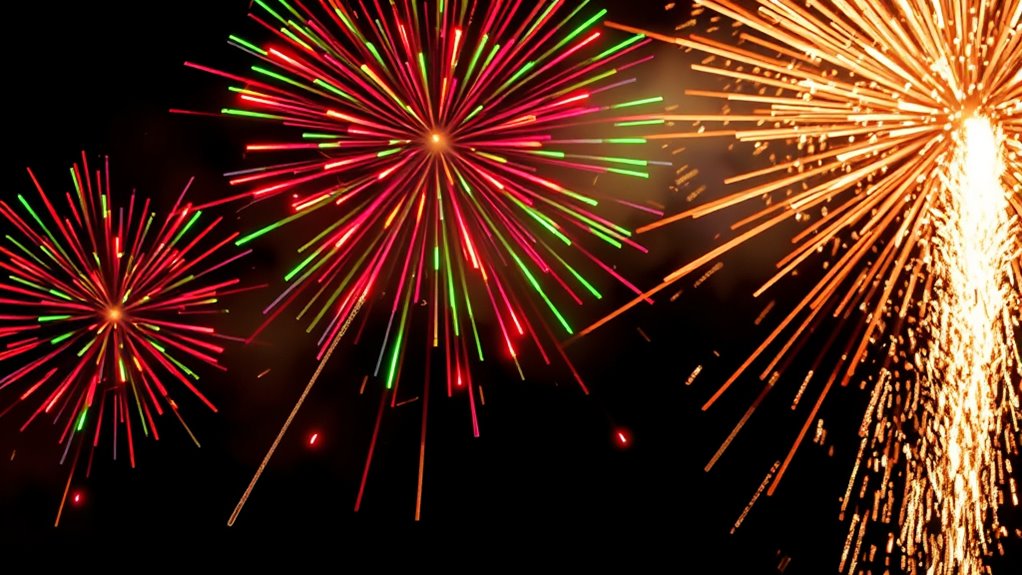
Have you ever wondered how fireworks produce their vibrant colors? It all comes down to electrons in metal atoms getting “excited” by heat during combustion. When these electrons jump to higher energy levels and fall back, they emit photons—particles of light—that create specific colors. Each metal’s unique electron configuration determines the wavelength of light released, giving each color its distinct hue. Humor in divorce can sometimes serve as a metaphor for the unpredictable reactions in pyrotechnics. The heat source comes from burning fuels and oxidizers, which provide the energy needed for excitation. Metal salts decompose under high temperatures, releasing metal atoms or ions that emit light as they return to lower energy states. Variations in flame temperature and chemical environment influence the hue and intensity, making the chemistry behind fireworks a precise balance of reactions.
Common Colors and Their Metal Sources

Vivid colors in fireworks rely on specific metal compounds that emit characteristic hues when heated. For red, you’ll see strontium compounds like strontium nitrate or carbonate, mainly sourced from the mineral celestite, with the U.S. importing most of its supply from Mexico.
Copper compounds such as copper chloride produce blue flames, with copper ore primarily mined in Arizona and other states.
Barium compounds, like barium nitrate from barite, give bright green colors; the U.S. imports most of this from China.
Sodium nitrate, sourced from the Atacama Desert or synthesized, creates intense yellow flames.
Finally, metals like aluminum, titanium, zirconium, and magnesium generate white sparks, while iron filings produce orange sparks.
Combining these metals allows for a broad spectrum of vibrant, dazzling fireworks displays.
Innovations and Techniques for Enhanced Visual Effects
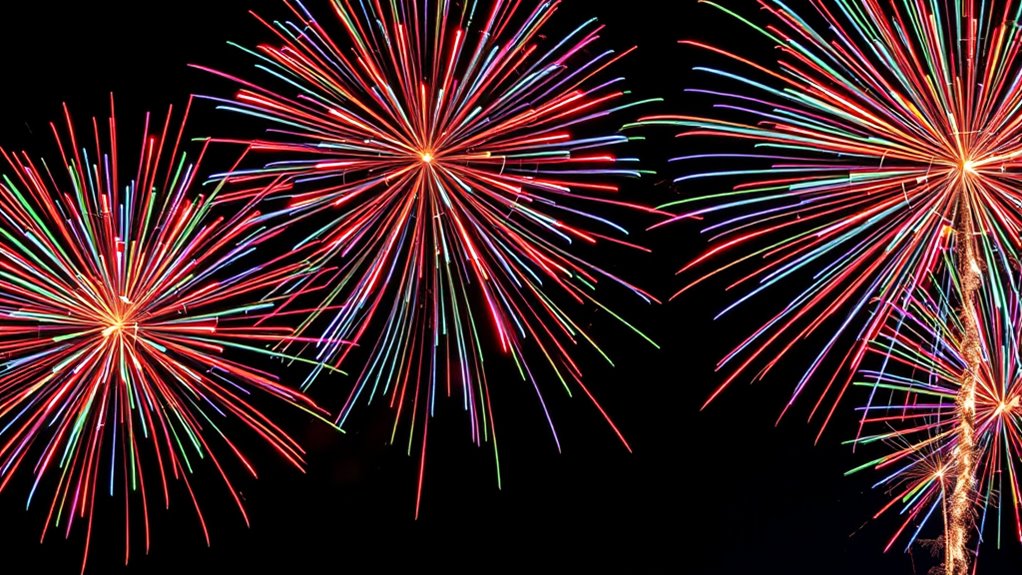
Recent advancements in pyrotechnic chemistry have opened new horizons for creating more dazzling and dynamic visual effects in fireworks. You can now use advanced chemical formulations, like organic ligands and mixed-metal compounds, to boost color brightness and expand hue ranges. Incorporating chelating agents helps control burn rates, prolonging vivid emissions. Particle size optimization enhances light scattering for more intense colors. Layered star designs, such as multi-layered or core-shell structures, produce color-changing and sparkling effects. Temperature and combustion control techniques, including tailored fuels and micro-encapsulation, sharpen color purity and stability. Additionally, innovations like strobes, crackles, reflective metal flakes, and phosphorescent coatings add complexity and shimmer. Environmentally conscious developments, like cleaner-burning and biodegradable materials, guarantee spectacular displays without harming the environment. Implementing proper training and safety protocols ensures that pyrotechnicians can operate these advanced techniques securely and effectively.
Frequently Asked Questions
How Do Environmental Factors Influence the Colors of Fireworks?
Environmental factors like temperature, humidity, wind, and atmospheric conditions directly influence the colors of fireworks. Warmer or more humid air can enhance or dull color intensity.
Wind can disperse colors unevenly, affecting the overall display. Weather conditions also impact visibility and brightness, making colors appear more vibrant or washed out.
Additionally, pollution and atmospheric composition can alter how colors are perceived, sometimes reducing their brilliance or changing their hues during fireworks displays.
Can Specific Metal Compounds Be Used to Produce Custom Colors?
You can absolutely mix and match metal compounds to craft your own colors in fireworks—think of it as painting with fire. By combining elements like barium for green or strontium for red, you shape vivid displays.
Experimenting with different salts, such as copper for blue or sodium for yellow, opens up a world of possibilities. Just remember, careful chemistry turns your creative spark into a dazzling, colorful explosion.
What Safety Measures Are in Place During Fireworks Manufacturing?
You need to follow strict safety measures during fireworks manufacturing to prevent accidents. Confirm buildings are single-story with weak walls facing away from other structures, and maintain smooth, noncombustible interior surfaces.
Prohibit open flames, smoking, and electrical heaters, and install proper ventilation. Keep fire extinguishers nearby, maintain clear exits, and conduct regular safety training.
Always comply with OSHA and ATF regulations, and coordinate with emergency services to ensure a safe working environment.
How Do Digital Technologies Enhance Firework Displays?
Digital technologies boost firework displays by making them more dynamic and precise. You can see synchronized shows where drones with LED lights move in harmony with fireworks and music, creating stunning 3D shapes and effects.
Choreography software helps you plan complex arrangements, while control systems guarantee perfect timing. These innovations let you enjoy safer, more creative, and immersive experiences, transforming traditional fireworks into modern, interactive spectacles.
Are There Eco-Friendly Alternatives to Traditional Firework Chemicals?
Imagine fireworks as your smartphone’s battery—both can harm the environment. You might wonder if eco-friendly options exist. Yes, they do! You can choose biodegradable packaging, clean-burning fuels, and less toxic chemicals like bromides.
Drones and laser shows also offer stunning displays without pollution. By supporting these innovations, you help reduce environmental harm, making celebrations greener and more sustainable for future generations.
Conclusion
Now you see how fireworks burst with brilliant colors thanks to clever chemistry and metal salts. By understanding the science behind each hue, you can appreciate the artistry and precision that goes into every display. Remember, “a picture is worth a thousand words,” but a fireworks show is worth a thousand feelings. So, next time you watch those dazzling sparks, you’ll know the science making them so spectacular. Fireworks truly turn science into art.
